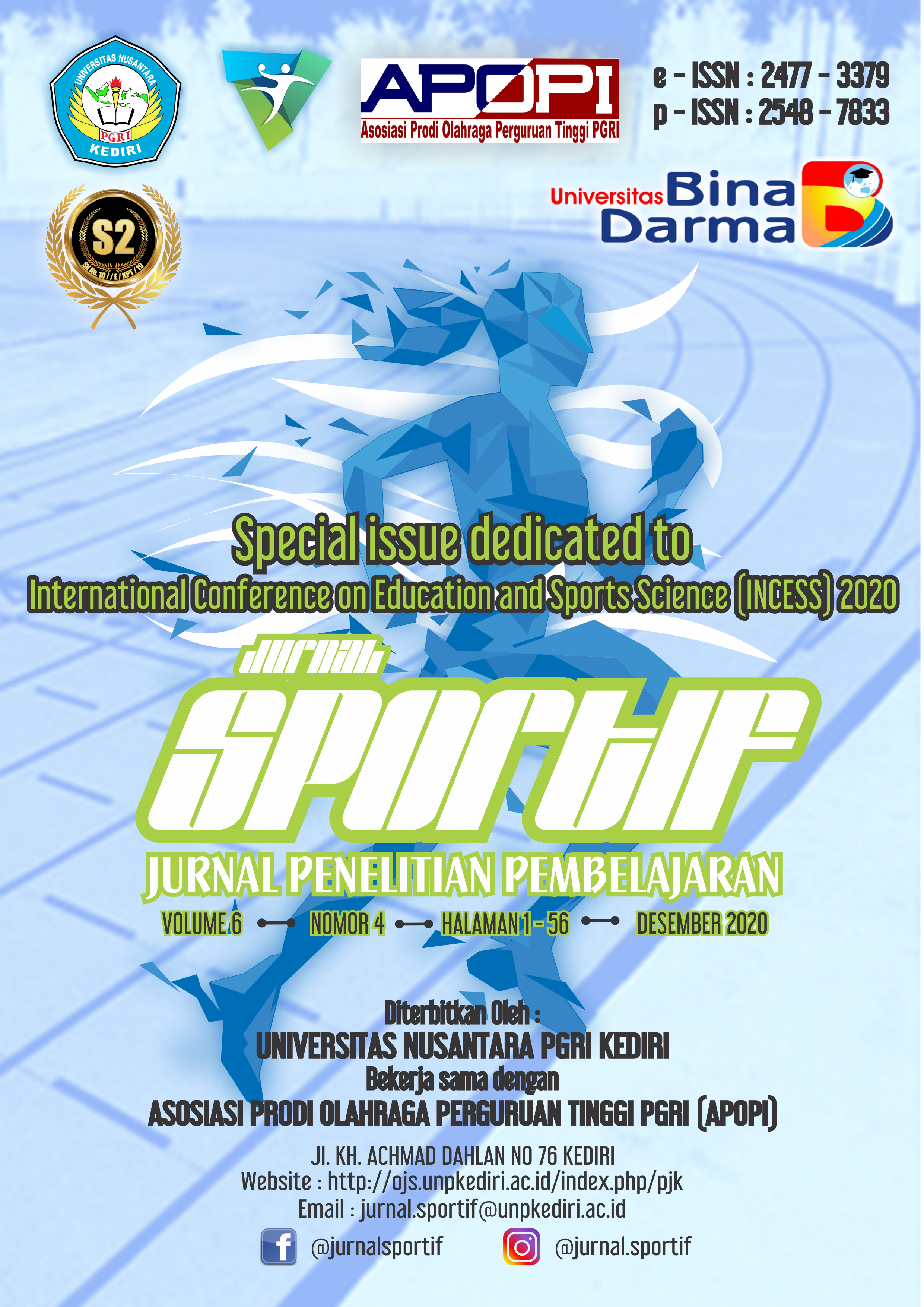Abstrak
The purpose of the research is to know the effect on the modification of “throwing-catching ball” in manipulative skill intellectual disability children. This study used quasi-experimental with a pretest-posttest design. Based on sampling technique with purposive sampling, this research used 10 samples. This research used the throwing-catching the ball instrument test. After analyzing data, value of the pretest was obtained with an average value of 3,8, minimum data 1, maximum data 6, and with a range of 5. Meanwhile of the posttest was obtained an average value of 10, minimum data 6, maximum data 2, and with range 6. Based on the results of t test showed 0,005 < 0,05. Meaning that there is an effect on the modification of “throwing-catching ball” in manipulative skill intellectual disability children. Hopefully, this research can be used as a basis for the next research, by paying attention on characteristics of intellectual disability children who require special assistance and learning and be more creative in developing game models to improve the manipulative skill on intellectual disability children.
Referensi
Andhini, N. F. (2017). Pengaruh Pergaulan Teman Sebaya Terhadap Pembentukan Karakter Siswa Kelas VIII Mts Negeri 3 Kabupaten Tangerang. Journal of Chemical Information and Modeling, 53(9), 1689-1699.
Ardiyansyah, W. (2017). Modifikasi Permainan Lari Estafet Untuk Meningkatkan Gerak Dasar Manipulatif Anak Tunagrahita Ringan (Studi Pada SDLB Merdeka Kecamatan Candi Kabupaten Sidoarjo). Jurnal Pendidikan Olahraga dan Kesehatan, 4(1).
Arifin, M. Z., & Kumaat, N. A. (2017). Pengaruh Modifikasi Permainan Lempar Tangkap Bola Terhadap Koordinasi Gerak Manipulatif Anak Tunagrahita Ringan Siswa Smplb-C Alpha Kumara Wardhana II Surabaya. Jurnal Kesehatan Olahraga, 7(3), 35-39.
Chen, W., Mason, S., Hammond-Bennett, A., & Zalmout, S. (2016). Manipulative skill competency and health-related physical fitness in elementary school students. Journal of sport and health science, 5(4), 491-499.
da Silva, R., & Silva, G. P. (2009). Anthropometric and Nutritional Characteristics of Mentally Disabled Persons. Fitness & Performance Journal (Online Edition), 8(2).
Hendra, J., & Putra, G. I. (2019). Mengembangkan Keterampilan Gerak Dasar Manipulatif Bagi Anak Melalui Permainan Olahraga di Taman Kanak-Kanak. Jurnal Muara Pendidikan, 4(2), 438-444.
Hidayati, N. (2016). Model Pembelajaran yang Efektif Bagi Siswa Tunagrahita di Sekolah Menengah Pertama Luar Biasa (SMPLB) BINTARA CAMPURDARAT TULUNGAGUNG (Doctoral dissertation, Universitas Islam Negeri Maulana Malik Ibrahim).
Kesumawati, S. A., Rahayu, T., Rachman, H. A., & Rahayu, S. (2018, May). Fundamental Movement Skills Game on Intellectual Disability Children in Primary Special Education. In International Seminar on Public Health and Education 2018 (ISPHE 2018). Atlantis Press.
Kustiawan, A. A., Prayoga, A. S., Wahyudi, A. N., & Utomo, A. W. B. (2019). Peningkatkan hasil belajar gerak dasar manipulatif menggunakan modifikasi alat bantu pembelajaran sederhana di sekolah dasar. Jurnal Pendidikan Jasmani Indonesia, 15(1), 28-32.
Lucas, M. D. (2017). How to Develop Modified Sports Programs for Children with Disabilities in Small Town America. Palaestra, 31(2).
Martinus, M., & Kesumawati, S. A. (2020). Pelaksanaan Permainan Gerak Dasar Manipulatif Pada Anak Tunagrahita Di SDLB C Kota Palembang. Kinestetik: Jurnal Ilmiah Pendidikan Jasmani, 4(1), 117-121.
Milteer, R. M., Ginsburg, K. R., & Mulligan, D. A. (2012). The importance of play in promoting healthy child development and maintaining strong parent-child bond: Focus on children in poverty. Pediatrics, 129(1), e204-e213.
Mirawati, M., & Rahmawati, E. (2017). Permainan Modifikasi Untuk Stimulasi Keterampilan Gerak Dasar Manipulatif Anak Usia 2-4 Tahun. Early Childhood: Jurnal Pendidikan, 1(2), 38-50.
Mkabile, S., & Swartz, L. (2020). ‘I Waited for It until Forever’: Community Barriers to Accessing Intellectual Disability Services for Children and Their Families in Cape Town, South Africa. International journal of environmental research and public health, 17(22), 8504.
Nugraha, L., Mahendra, A., & Herdiyana, I. (2018). Penerapan Model Pendidikan Gerak Dalam Pengembangan Pola Gerak Dasar Manipulatif Melalui Kerangka Analisis gerak (Movement Analysis Framework). TEGAR: Journal of Teaching Physical Education in Elementary School, 1(2), 24-32.
Nursalim, M. (2007). Psikologi pendidikan. Surabaya: Unesa University.
Ross, S. M., Bogart, K. R., Logan, S. W., Case, L., Fine, J., & Thompson, H. (2016). Physical activity participation of disabled children: A systematic review of conceptual and methodological approaches in health research. Frontiers in public health, 4, 187.
Soemantri, S. (2006) Psikologi Anak Luar Biasa. Bandung: Refika Aditama. Bandung: Refika Aditama.
Sumantri, M. S., & Endrawati, T. (2013). Kemampuan Sosialisasi dan Gerak Manipulatif Berbasis Kelompok pada Anak Usia 4-5 Tahun. Jurnal Ilmiah Visi, 8(2), 104-110.
Supriyanto, J. (2008) Gembira Berolahraga. Solo: Tiga serangkai.
##submission.copyrightStatement##

